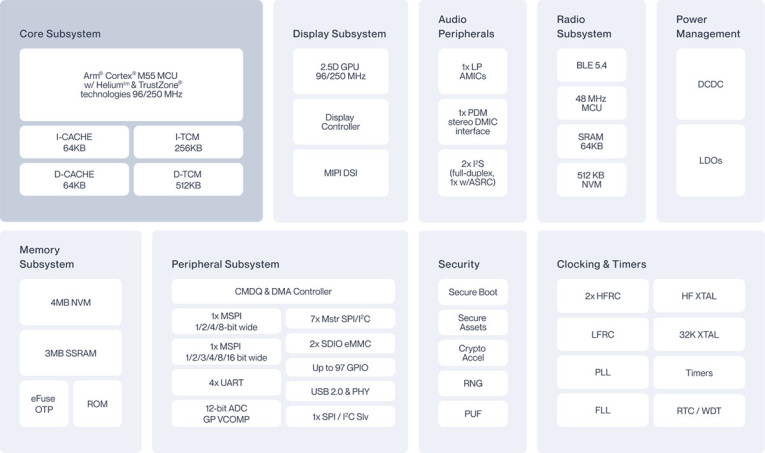
The Arm Cortex-M55 processor with Helium and turboSPOT delivers up to 30x better power efficiency in AI applications and 16x faster performance over Cortex-M4 devices. Other specifications for the new Ambiq Apollo510B SoC detail an enhanced memory architecture with 64KB I-cache and 64KB D-cache, 3.75MB of system RAM, and 4MB of embedded non-volatile memory, plus an advanced GPU with 2D/2.5D with vector graphics acceleration.
The Apollo510B also offers comprehensive peripheral support, including ADC, SPI, I2C, UART, and high-speed USB 2.0. Audio systems are supported with an ultra-low power ADC and stereo digital microphone PDM interfaces, ready for secure, always-on, smart devices.
“The Apollo510B’s rich set of peripherals makes it ideal for always-on, intelligent, and connected devices, particularly in body-worn and ambient AI applications. Its advanced memory architecture enables fast execution and real-time data processing, while secureSPOT 3.0 and Arm TrustZone provide secure boot, firmware updates, and protection of interoperability and data exchange across diverse edge devices,” Ambiq states in the announcement.

With Ambiq’s graphiqSPOT graphics engine, the Apollo510B delivers responsive visuals for an immersive user interface while maintaining power efficiency. With the Arm Cortex-M55 running at up to 250MHz with a Helium AI accelerator, coupled with the hardware-accelerated vector graphics, anti-aliasing, dithering, full alpha blending, and MiP (Memory-in-Pixel) display technologies, developers can gain the flexibility and performance needed to bring real-time, always-on intelligent devices to market.
“We are excited to expand our latest generation microcontroller with the Apollo510B,” says Scott Hanson, CTO at Ambiq. “The integration of a low-power Bluetooth radio further extends the possibilities we can provide manufacturers to create the most advanced connected devices powered by edge AI.”
The Apollo510B SoC will be available in Fall 2025.
www.ambiq.com






